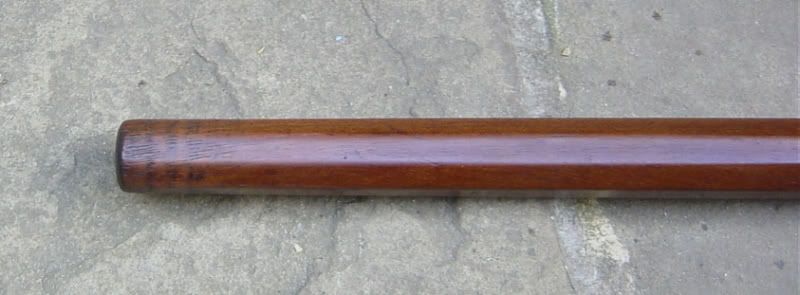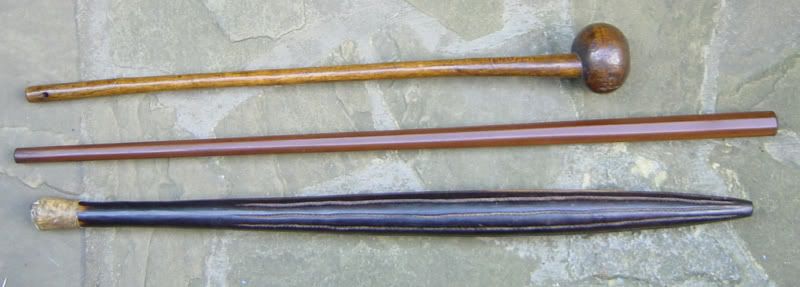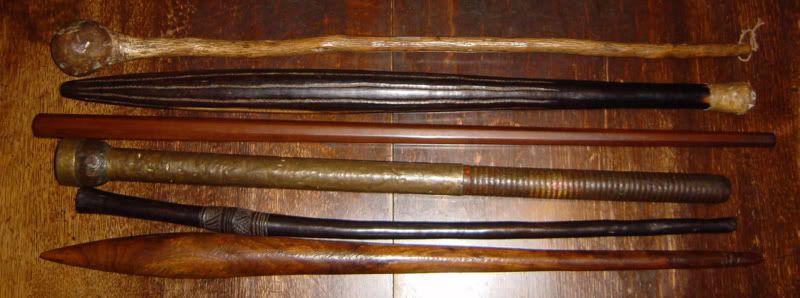
 |
|
|
#1 |
|
Member
Join Date: Dec 2004
Location: What is still UK
Posts: 5,936
|
Or further a field. Found this Sunday just gone. I think it is extreamly nice. You can see where some binding/lanyard has been at the handle end. I know there are many forms of pole clubs from the south seas and I feel sure I have seen this octagonal form before. Not weapons we see much of here? Opinions and other examples would be great. It may just look like a stick, that is untill you have it in your hand. I show it next to a massive Dinka club and a fairly standard size Kerrie.
   
Last edited by Tim Simmons; 1st September 2008 at 09:23 PM. Reason: spelling |
|
|

|
|
|
#2 |
|
Member
Join Date: Dec 2004
Posts: 1,247
|
Sure it's not Japanese?
|
|
|

|
|
|
#3 |
|
Member
Join Date: Dec 2004
Location: What is still UK
Posts: 5,936
|
I know nothing about Japanese weapons fearn. I can see your thoughts in the purity of form, not unusual in the South Seas too.
Somebody out there knows about Japanese wood clubs? a peasants weapon? perhaps a police baton? I have a heavy boken of similarly dark coloured wood but seems quite different wood really, perhaps because it is not old like the club. I would rather it was from the Melanesian world. I have very small information about pole clubs in New Ireland but there are many other islands in the region. Help please? Last edited by Tim Simmons; 2nd September 2008 at 08:13 AM. |
|
|

|
|
|
#4 |
|
Member
Join Date: May 2007
Posts: 93
|
Hi Tim, the form of your club does look like a Japanese kanabo but the ones I've handled are much bigger-about 4-5 feet long and have strips of studded iron attached to them. The bottom half of kanabo are often carved with ribbing looking as if they were turned on a lathe but probably applied by hand.
Hope this helps, Graham |
|
|

|
|
|
#5 |
|
Member
Join Date: Dec 2004
Posts: 1,247
|
Hi Tim,
I was thinking of the Japanese hanbo, which is about 3 feet long and 1 to 1.5 inches diameter. It might have a hole drilled near one end for a wrist loop. Basically, the smooth, relatively even club with an octagonal cross section seems like a Japanese thing to me. Without doing a (destructive) wood test, there's not much way to tell, unless you have something in the way of provenance. Anyway, it's just my opinion. I'd be happy to be wrong. F |
|
|

|
|
|
#6 |
|
Member
Join Date: Dec 2004
Location: What is still UK
Posts: 5,936
|
F you are not wrong. At least it is an old one. Another piece to put at the back of the wardrobe.
|
|
|

|
|
|
#7 |
|
Member
Join Date: Dec 2004
Posts: 1,247
|
Hi Tim,
Glad to help. Perhaps it needs a home behind the door, for providing a warm and friendly welcome to any visiting neds...  F |
|
|

|
|
|
#8 |
|
Member
Join Date: Jul 2006
Location: musorian territory
Posts: 481
|
could most likely be fiji or could be tonga both areas octagonial clubs were common.. , actualy fijian clubs were traded all around the pacific due to their quality and hardness of woods found in fiji.
|
|
|

|
|
|
#9 |
|
Member
Join Date: Dec 2004
Location: What is still UK
Posts: 5,936
|
You sound such a nice chap
 I had hopes but have lost my confidence. I can say as can be seen, it has an all over smooth patina which I have not seen on martial arts kit. The octagonal carving in real space seems less precise that one would think of Japanese work or is that just hope. Look at the patina of all three clubs. |
|
|

|
|
|
#10 |
|
Member
Join Date: Dec 2004
Posts: 1,247
|
Hi Tim,
The thing is that the Japanese martial arts community seems to have set standards for the different stick sizes, so one way to check the origin is to get out your tape and measure length and diameter. If it's close to 30" and between 1 and 1.5", it's quite possibly a hanbo. If it's not close to these measurements, it's more likely something else. F |
|
|

|
|
|
#11 |
|
Member
Join Date: Dec 2004
Location: What is still UK
Posts: 5,936
|
It is 34" long and just over an inch at the distal end . Is that near or off Japanese standard size? The polish and patina to the wood does give me a little hope to hold on to. I know that todays martial arts kit is not polished or has patina but would one from the late 19th early 20th century be so
Having googled images "hanbo" I am no longer so sure it is a hanbo. Like swords most stick weapons are in universal size perameters. The Japanese may have famous schools and names for weapons but lets not forget that a club or stick weapon is exactly that and the South Seas peoples fought with clubs for thousands of years surely they new all the moves or more too. There is something about the finish so similar to all my other clubs that also makes me not so sure any more of it being a hanbo but the doubt the other way is still there, sadly.  Certainly untill better information or another edxample is shown. Certainly untill better information or another edxample is shown.
Last edited by Tim Simmons; 5th September 2008 at 08:45 PM. Reason: adding |
|
|

|
|
|
#12 |
|
Member
Join Date: Dec 2004
Posts: 1,247
|
Well, you've got me scratching my head. Back 100 years ago, the Japanese arts weren't so rigidly systematized, sooo....
 I figured that exact dimensions would give a match. Inexact dimensions? Not sure what that means. Reminds me of an aikido teacher who gave a jo (4' staff) seminar. He insisted that the proper height was the height of your heart. My 4' stick was a bit too short, and I noticed it when spinning the stick. I still need to see a good match from Oceania, though. F |
|
|

|
|
|
#13 |
|
Member
Join Date: Jul 2006
Location: musorian territory
Posts: 481
|
hmm i had an old catalouge from an australian ethnic weapons dealer , must have been about 20 years old,, and in it were listed a large array of fijian fighing staffs in octaginal section ,, shown just as yours .. in variang lenths , i belive some may have an a small nob on the grip also dont remember.. focrise , things like native clubs are always mislabled , so they could have just aswell came from any other area in the pacific..
japanese use wood plains.. and so their carving is nice and even as any in europe from the same era,, also they use woods from their locality , none of which are very dense being a temperate zone.. so look at the wood and at the working of it and youll be able to tell...... or ask some japanese wood worker if he kniws the wood.. |
|
|

|
|
|
#14 |
|
Member
Join Date: Dec 2004
Location: What is still UK
Posts: 5,936
|
Getting warmer. Handle end just a little different. Vanuatu sounds cool to me. Still searching.
http://collections.tepapa.govt.nz/ob...regno=fe000679 Last edited by Tim Simmons; 17th October 2008 at 10:44 PM. Reason: spelling |
|
|

|
|
|
#15 |
|
Member
Join Date: Dec 2004
Location: What is still UK
Posts: 5,936
|
I am not sure how relevant this is but compere the "club" with the spear halft. The other side of the spears is rounded I imagine because the wood on this side is inpregnated with the pithy heart wood as can be seen in the link.
http://www.vikingsword.com/vb/showthread.php?t=7284 Also there is some relation to the club from the New Zealand museum link in the earlier reply. If you ignore the difference in handle both clubs are truncated pure froms. |
|
|

|
|
|
#16 |
|
(deceased)
Join Date: Dec 2004
Location: OKLAHOMA, USA
Posts: 3,138
|
THE END OF THE ITEM HAS THE DARK BANDS I ASSOCIATE WITH A DECORATIVE FIBER WRAP THAT IS NOW MISSING THRU NATURAL DRYING AND DETERIOATION AND BECOMING BRITTLEOVER TIME. THE FIBER WRAP IS SOMETIMES DECORATIVE AND SOMETIMES PLAIN AND SERVES THE FUNCTION OF PROVIDING A GOOD GRIP IN MOST CASES. THIS IS COMMON THRU OUT OCEANIC SOCIETYS SO DOSEN'T HELP PIN IT DOWN MUCH. THE LOOK OF THE WOOD AND THE EVIDENCE OF A WRAP DOES CAUSE ME TO SUSPECT IT IS NOT AFRICAN OR AUSTRALIAN ABORIGINAL BUT THATS ABOUT ALL I CAN DEDUCE FROM IT.
THE SHAPE IS NOT SOMETHING I HAVE PERSONALLY SEEN OR SOMETHING I HAVE NOTICED IN MY REFRENCES. I WOULD HAZZARD A GUESS BASED ON A GUT FEELING THAT IT NOT A CLUB BUT A CHIEFS STAFF OR A SPEAKERS STAFF. BOTH WERE USED THRU OUT POLYNESIAN SOCIETYS AND WERE OFTEN PLAIN WITH NO TIKI DECORATIONS OR SYMBOLIC MARKINGS. THEY WOULD BE MORE RARE THAN WAR CLUBS AS ONLY ONE WOULD BE MADE FOR THE VILLAGE OR IN SOME CASES SEVERAL VILLAGES. THE STAFFS WITH SYMBOLS OR MARKINGS USUALLY HAD SOMETHING TO DO WITH CEREMONIES AND RITUALS AND SHAMAN OR WITCHDOCTORS. THE CHIEFS STAFF WAS A SYMBOL OF THE CHIEFS POWER AND WAS NOT INTENDED TO BE A WEAPON OR BE USED IN CEREMONIES. THE SPEAKERS STAFF WAS OFTEN PLAIN AND USED AT TRIBAL MEETINGS WHERE IMPORTANT THINGS WERE BEING DISCUSSED AND RESOLVED, WHOEVER HELD THE STAFF HAD THE FLOOR AND WAS LISTENED TO BY ALL AT THESE GATHERINGS. PERHAPS YOU CAN FIND SOMETHING SIMULAR TO YOUR ITEM LOOKING IN REFRENCES UNDER THESE TWO CATAGORYS. NICE STICK WHATEVER IT IS  GOOD LUCK GOOD LUCK
|
|
|

|
|
|
#17 |
|
Member
Join Date: Dec 2004
Location: What is still UK
Posts: 5,936
|
Barry, your comments are most encouraging. A speakers staff is quite interesting. Having handled some Japanese martial arts kit I am now pretty sure it is not that sort of thing. I feel the similar tapering form of the Vanuatu club may indicate a Melanesian origin. There are many islands in this group and as shown in a previous thread about wooden knives forms vary from each Island. This is also not including other Melanisian Islands.
|
|
|

|
|
|
#18 |
|
Member
Join Date: Dec 2004
Location: What is still UK
Posts: 5,936
|
This is good stuff. I have the book on it's way to me. Scroll to contents and click on "hunting,warfare,and communiction"
http://books.google.co.uk/books?hl=e...result#PPP1,M1 |
|
|

|
|
|
#19 |
|
Member
Join Date: Dec 2004
Location: What is still UK
Posts: 5,936
|
I have the book now. I cannot spend the time to upload all the information further than where the link in the last reply left off "hunting, warfare, and communication". All I can say is that much reference was made to the simple truncated cone shape club. There is illustrations of a great many clubs, scores, just not the one I have, some very similar. Also images of how fibres were bound at the handle end and a loop to fit on the shoulder so the club hung out of the way next to the body. Reference is also made to the great "fencing skill" in the use of these clubs. The survey of the Vanuatu group of islands was carried out in 1912, at that time real clubs had ceased to be made and acurate information on all forms from the islands was no longer available. I would suggest any interested parties to purchase a copy. I am now certian of my original supostion of a Melanesion club quite probably from the Vanuatu islands but equally a possible origin from New Caledonia, New Britain, New Ireland, New Hebrides, Solomans possibly even Fiji which can be included in Melanesian study. I am confident it is not from Papua.
|
|
|

|
|
|
#20 |
|
Member
Join Date: Dec 2004
Posts: 1,247
|
Hi Tim,
I've followed the link, and in reading the text on short clubs (p. 205 and following), I'm getting confused. Since the relevant plates aren't given in the preview text, I'm limited to the written descriptions. In those descriptions, the author pretty consistently talks about short clubs having distinct grips and heads, which we definitely don't see on this specimen. Since you actually have the book, it would be wonderful if you could either point to the text where he talks about octagonal clubs such as this specimen. I'm assuming I missed it, and I'd like to see what I missed. F |
|
|

|
|
|
#21 |
|
Member
Join Date: Dec 2004
Location: What is still UK
Posts: 5,936
|
Fearn it is not for me to suggest what you may have missed. A few points to keep in mind. I think I am not forming an opinion based on the mind set of a creationist. We are only looking at one part of Melanisia just here, where clearly stated all forms are unkown. Agreed the form in question is not mentioned or illustrated, many of the forms illustrated are indeed also not mentioned. How hard is it to facet a cone form? rather in the same way as the spear? The "club?" in question has had some binding at the thin end. In these pictures I find the throwing stones most interesting they are around 30cm long. The log shaped ones are coral. It is exactly these problems of attributing age and origin that only a decade or two past put ethno weapon in the bargian basement of collecting, look what has happened now that people have bothered to do basic research? almost knocking antique military weapons into a tricorn hat.

|
|
|

|
|
|
#22 |
|
Member
Join Date: Dec 2004
Posts: 1,247
|
Cool! Thanks Tim!
I'm glad you took the time to upload all of those plates. It really helps in understanding the text. As for faceting a cone, I don't know how hard it would be for the woodworker. I do know that the two times I've tried to make an even octagon out of a dowel, I've failed miserably. That probably says more about my minimal woodworking abilities than anything else, but I do think that it's a little more difficult than it looks. The problem I ran into was keeping the facets even the length of the dowl. I agree with you on the throwing stones. Those are neat. Wonder if any of those will show up in collections? F |
|
|

|
|
|
#23 |
|
Member
Join Date: Dec 2004
Location: What is still UK
Posts: 5,936
|
Just digging around and found this picture of a group of Samoans circa 1900. look at the club the chap has it the enlarged picture. looks like some kind of pole club.
|
|
|

|
|
|
#24 |
|
Member
Join Date: Dec 2004
Posts: 1,247
|
Who's the blackbirder they are looking at?
 
|
|
|

|
|
|
#25 |
|
Member
Join Date: Dec 2004
Location: What is still UK
Posts: 5,936
|
It seems this is most definately a hanbo. I have been shown one new, of exactly the same form except no binding. I cannot show as it is on ebay. Well if you do not try
 . .
|
|
|

|
|
|
#26 |
|
Member
Join Date: Jun 2005
Location: Little Rock, Arkansas
Posts: 89
|
I have greatly enjoyed this literate and expert discussion. If this is a Japanese "bo" (and I doubt that it is) it would likely be Japanese red oak.
Peter |
|
|

|
|
|
#27 |
|
Member
Join Date: Dec 2004
Location: What is still UK
Posts: 5,936
|
Thank you Peter.
I can compere it to this red oak heavy boken. It is quite different there is no oak like grain. The boken has a crude finish in comparrison. At my nearest shop for things like boken and other martial arts kit none seem to be polished. I do not know about old kit. |
|
|

|
|
|
#28 |
|
Member
Join Date: Dec 2004
Location: What is still UK
Posts: 5,936
|
This is interesting. I think it is okay to make link like this. Micronesian, Caroline islands so the site says. What is worth note is the discription, the coir binding at the handle. Although called a spear it is only 10 inches longer than my club.
http://www.cinoa.org/exhibits/42804 |
|
|

|
 |
| Thread Tools | Search this Thread |
| Display Modes | |
|
|